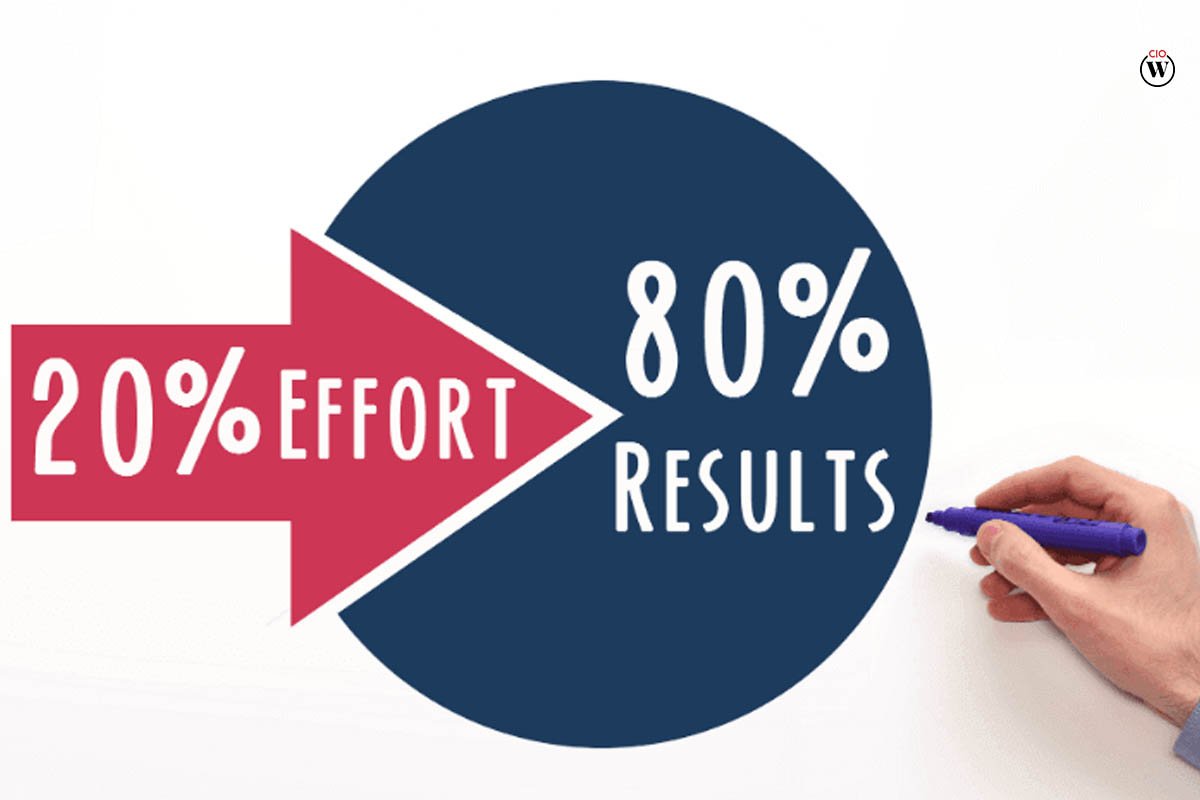What Is the 80-20 Rule?
This commonplace adage, also known as the Pareto Principle or the 80-20 rule, states that 20% of actions or factors will account for 80% of the effects of that action or factor. The 80/20 Rule of Productivity is used in business to focus on the factors that are likely to provide the highest returns. For instance, after determining which elements are most important to the growth of a business, managers should devote their time and energy exclusively to those elements.
The 80/20 Rule of Productivity is most often seen in economics and business, although it applies to any subject. The 80/20 Rule of Productivity may be applied to any number of topics, including wealth inequality, personal economics, spending habits, and even cheating in romantic relationships.
Here is the 80/20 Rule of Productivity;
1. What Is the 80-20 Rule and How Does It Function?
It’s easy to see how the 80/20 Rule of Productivity may be seen as a straightforward case of cause and effect: In other words, the most common 80/20 rule states that just 20% of inputs result in 80% of effects (inputs). The 80/20 rule is a common way to explain how 20% of a company’s clientele is responsible for 80% of the income.

From this perspective, it might be beneficial for a business to target its marketing efforts on the 20% of customers that generate 80% of sales. The firm may be able to keep them as customers and attract new ones who share its values and priorities. There is, however, a deeper significance to the 80-20 rule.
2. Core Principle
The 80-20 rule emphasizes the importance of zeroing in on and making the most of an organization’s most valuable assets. One good strategy is to prioritize studying the sections of a textbook that will help the most on an upcoming test. However, this does not mean that the learner may skip through the rest of the book.
3. Misinterpretations
The 80/20 Rule of Productivity is often misunderstood since it is presented as a mathematical law when in fact it is more of a precept. In addition, it is not required that the sum of the percentages equals 100%. Simply expressed, inputs and outputs stand for distinct measurement systems. It’s not necessary for the total percentages of these units to equal 100. The idea underlying the regulation is what counts.

Another way the 80/20 Rule of Productivity is misunderstood is in its application. More specifically, the idea is that if 20% of inputs are crucial, then the other 80% must be unimportant. This is an error in reasoning. Even if it’s decided that the top 20% should get the most attention, the other 80% may still be significant.
4. Background of the 80-20 Rule
When doing Pareto analysis, the 80/20 Rule of Productivity is often used. This rule is also known as the Pareto principle. In the early 20th century, it was initially used in macroeconomics to explain Italy’s wealth distribution. Vilfredo Pareto, an Italian economist, is credited with introducing the ideas of Pareto efficiency in 1906.
Eighty percent of the peas came from twenty percent of the pea pods, a fact that was observed by Pareto. Pareto generalized this idea to the economy as a whole, demonstrating that just 20% of Italians held 80% of the country’s wealth.
The 80-20 rule was first used for quality control in business production by Dr. Joseph Juran, a pioneer in the area of operations management, in the 1940s.
He proved that flaws in manufacturing procedures accounted for 80 percent of all product faults. An organization may improve the quality of its output by twenty percent just by identifying and fixing the most pressing issues in production. Juran used the phrase “the important few and the inconsequential multitude” to describe this dichotomy.
5. Benefits of the 80-20 Rule
There isn’t a lot of hard data to back up the 80/20 Rule of Productivity, but anecdotal evidence suggests it holds in most cases.
Incorporating the 80-20 rule into sales performance has shown positive effects across industries. Many successful management methods, such as Six Sigma and the 80/20 Rule of Productivity, have been developed by external consultants.
6. Application of the 80-20 Rule
Carla, a student at Harvard’s graduate level, was deep in concentration on a project for her digital communications course. The task at hand was to launch a blog and track its performance over a trimester.
Carla conceived, built, and unveiled the website. About two-thirds of the way through the semester, the instructor assessed the blogs’ efficacy. Carla’s blog, despite its success, received far less traffic than those of her classmates.
Problematize It
Carla read an article on the 80/20 Rule of Productivity. It was said that this idea may be implemented in any sphere. So, Carla pondered how the 80-20 rule might be applied to her blogging endeavor. The question crossed her mind, “This blog is a product of many hours of my time as well as my technological knowledge and writing skills. Yet despite my best efforts, my website continues to get a negligible amount of visitors.”
She had finally realized that it didn’t matter how wonderful the material was if nobody read it. Carla realized that the failure of her blog’s promotion may have been more significant than the blog’s content itself.
7. Apply the 80-20 Rule
Carla used the 80/20 Rule of Productivity and committed 80% of her time, energy, and focus to the blog’s creation, content included. A minority of her blog’s readers would stand in for her 20%.
Carla employed web analytics to pay careful attention to the number of visitors to the blog. So, she pondered to herself:
Who are the top 20% of visitors to my blog?

Who makes up the most important 20% of my target market?
Who exactly makes up this target demographic, and what are their shared traits?
How much of an increase in budget and effort might be justified to better serve my most loyal 20% of readers?
Which 20% of my blog subjects have generated the most interest from readers?
Is there anything I can do to make those pieces of content even more popular?
Carla analyzed the answers to these questions, and edited her blog accordingly:
She made changes to the layout and tone of the blog to attract the top 20% of her ideal readers (a strategy common in micromarketing).
To better serve her intended audience, she changed certain material.
Carla’s investigation confirmed that the blog’s primary issue was its marketing, but she did not dismiss the blog’s substance. She did not want to make the same error as the one described in the essay, which holds that if 20% of inputs are most significant, then the remaining 80% must be unimportant. Some of the substance, she understood, would have to be discussed as well.
Results
Carla learned more about her viewers by using the 80-20 rule in her blog project, allowing her to focus on the top 20% of her followers.
Based on her newfound knowledge, she revised the blog’s layout and content, resulting in a 220% increase in readership.
What is the “80-20 Rule”?
According to the 80/20 Rule of Productivity, the top 20% of contributors to any given situation account for 80% of the effects. It is used to isolate the most influential determinants of success (usually in a business context) to optimize performance. The principle has wider applicability than only the corporate world.
What Does the 80-20 Rule Mean?
The 80-20 rule is a simple reminder to focus efforts where they will have the most payoff, whether it is in business, life, sports, music, a blog, etc. This, however, does not imply that the less prosperous parts of society should be ignored. It’s all about setting priorities, getting stuff done, and dealing with issues when they arise as a result of that.
How Do I Use the 80-20 Rule to Invest?
To maximize your profits, focus on the 20% of the S&P 500 that are responsible for 80% of the market’s gains. You might, for example, split your investment’s 80/20 Rule of Productivity, with the majority of your money going into low-volatility index funds and the remainder into growth stocks. Results in the past are no guarantee of future achievement. So, keep an eye on your portfolio’s stats to evaluate whether the outcomes are in line with your expectations.









